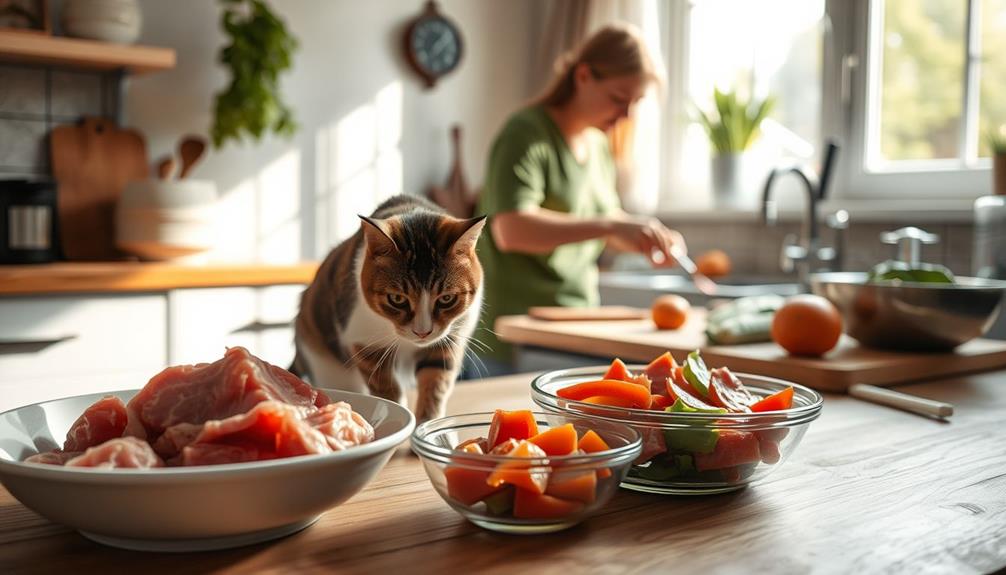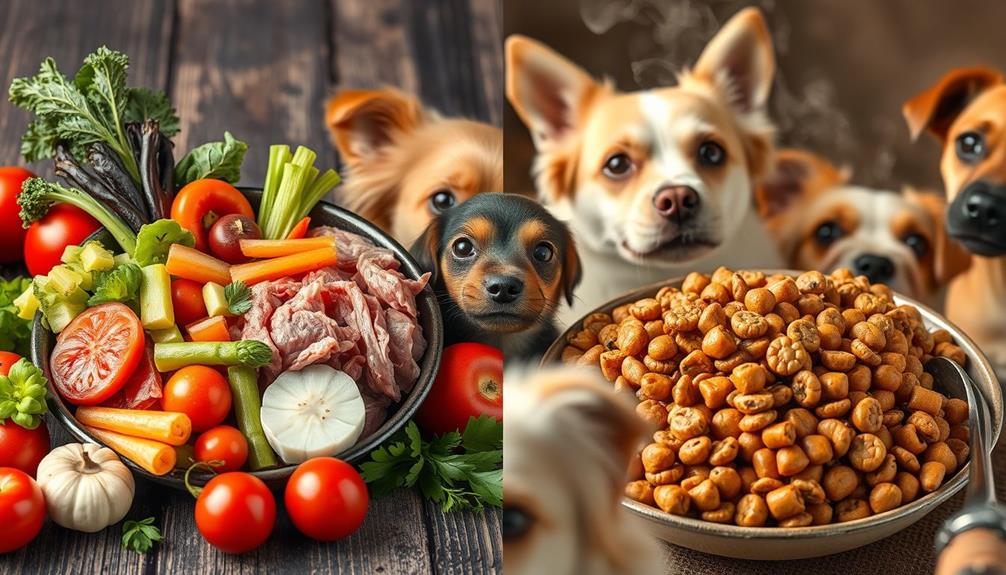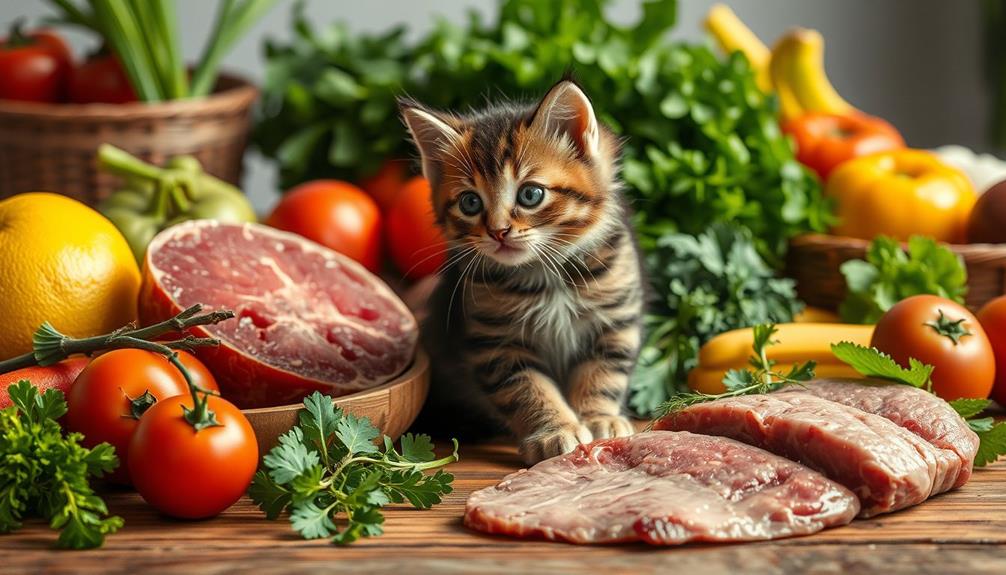Switching your cat to a raw food diet is a great way to boost their health. Start by mixing 10% raw food with their current diet. Gradually increase this over 2 to 4 weeks, monitoring their stool for any changes. Make sure the raw food is balanced and at room temperature for better palatability. Keep an eye on your cat's eating habits, as they can be picky. Always choose high-quality meat and maintain hygiene to prevent contamination. With patience and careful observation, you'll find it easier than you think. There's much more to exploring this change effectively!
Key Takeaways
- Begin by mixing 10% raw food with your cat's current diet to help them acclimate gradually.
- Monitor your cat's stool consistency and adjust the raw food percentage over 2 to 4 weeks.
- Serve raw food at room temperature to enhance palatability and mimic freshly caught prey.
- Use high-quality meat, balancing 83-85% muscle meat, 10-15% raw meaty bones, and 5-10% organ meat for optimal nutrition.
- Maintain strict hygiene practices to prevent contamination and ensure regular veterinary check-ups for health monitoring.
Health Benefits of Raw Diet
A raw diet offers several key health benefits for your cat, aligning closely with their natural dietary needs as obligate carnivores. When you feed your cat a raw food diet, you provide them with raw meat, organs, and bones that enhance their nutrient absorption, leading to improved vitality and overall health.
You'll notice how much more energetic and lively your cat becomes. Moreover, providing a diet rich in high-quality proteins can help prevent obesity and related health issues, which is essential for maintaining their long-term health and well-being. The importance of a balanced diet is echoed in many animal care practices, such as those found in ultimate hamster care guides.
One of the standout health benefits is the positive impact on skin and coat conditions. Cats eating raw often experience reduced shedding and fewer skin issues compared to those on commercial diets.
Additionally, the natural chewing action involved in eating raw not only satisfies their instincts but also promotes dental health by minimizing plaque and tartar buildup.
Furthermore, the high moisture content in a raw diet helps maintain ideal hydration levels, which is vital for urinary tract health.
Gradual Transition Process
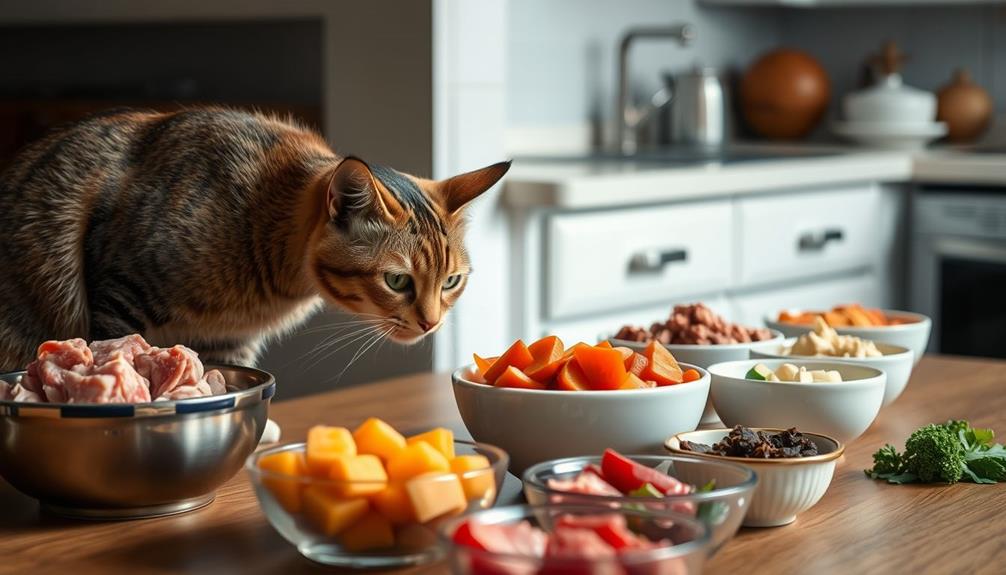
Shifting your cat to a raw food diet should be done gradually to guarantee a smooth adjustment. Start by mixing 10% raw food into your cat's current diet. This allows them to acclimate to the new flavor and texture without overwhelming their digestive system.
It's also important to make sure that the raw food is balanced and appropriate for their nutritional needs, as proper cold medications overview can play a crucial role in overall health. As you move your cat to the new diet, monitor your cat's stool closely; small, firm, and odorless stools indicate they're adjusting well to the raw diet.
Over the next 2 to 4 weeks, you should gradually increase the percentage of raw food in their meals. This slow shift helps prevent digestive upset and allows your cat's system to adjust.
Be patient—some cats may need several weeks to fully adapt to feeding raw. If your cat shows signs of finicky behavior or reluctance, don't rush the process; familiarity is essential for acceptance.
Throughout this period, keep an eye on how your cat responds to the new food. If you notice any digestive issues, consider slowing down the transition.
With time and patience, your cat will adjust to their new raw diet, leading to healthier eating habits and overall well-being.
Temperature Considerations
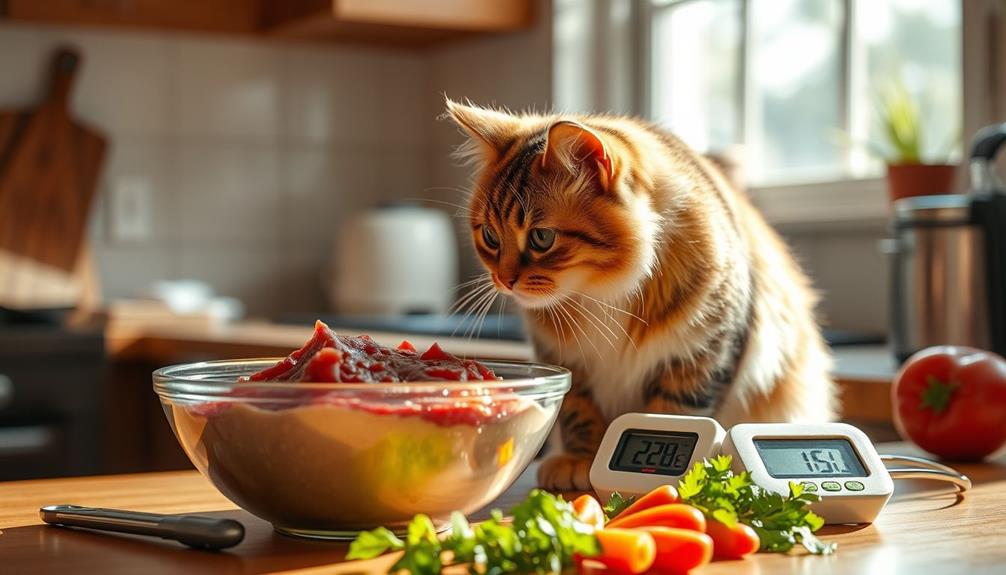
When serving raw food to your cat, temperature plays a crucial role in their willingness to eat. Cats generally prefer their food at room temperature, which enhances the palatability and makes meals more appetizing. To achieve this, let the raw food sit out for a short period before feeding. Aim for an ideal temperature of around 70°F (21°C).
Additionally, incorporating certain essential oils like eucalyptus oil for respiratory health can create a more pleasant feeding environment, as fresh air can encourage your cat's appetite.
Cold food straight from the refrigerator can deter your cat from eating, as their natural instincts favor the warmth of freshly caught prey. By monitoring the food temperature, you can greatly improve your cat's enjoyment and encourage them to shift smoothly from canned food to raw food.
If you notice your cat hesitating at mealtime, consider adjusting the temperature first. Ensuring the raw food is at the right temperature can help prevent waste, as cats are more likely to enjoy and consume food that feels familiar and appealing.
Feline Feeding Behavior
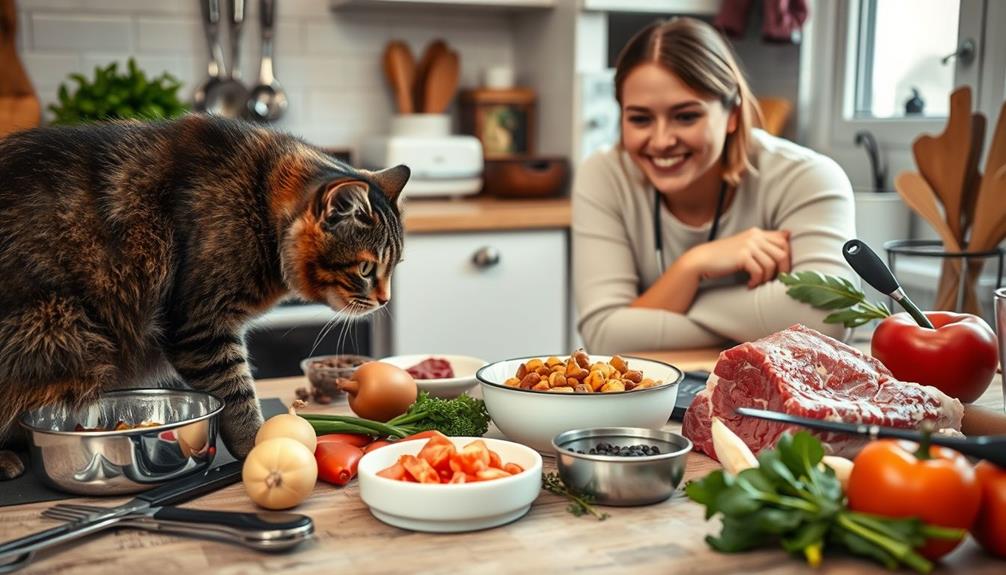
Understanding feline feeding behavior is essential for successfully shifting your cat to a raw food diet. Cats are instinctively driven by their predatory nature, making them selective eaters. If your cat has been on a single diet for a long time, you might notice finicky eating habits emerging, making it more challenging for them to try new foods, like raw options.
To support your cat's health during this change, consider incorporating healthy dog snacks that contain natural ingredients, which can encourage them to explore different flavors.
Unlike dogs, cats have a limited ability to taste sweet flavors, which reinforces their preference for high-protein, meat-based diets. When altering to a raw diet, be aware that flavor enhancers in commercial cat food can complicate this process. Your cat might reject natural raw foods if they're used to these additives.
Patience is vital during this change. Abrupt changes can trigger aversion or refusal to eat, leading to potential nutritional deficiencies. Instead, gradually introduce raw foods into their meals, allowing your cat time to adjust.
This method helps them adapt without feeling overwhelmed. By understanding and respecting your cat's feeding behavior, you'll make the change to a raw diet smoother and more successful.
Safety and Nutritional Guidelines

Successfully introducing raw food involves not just a change in diet but also a focus on safety and nutrition. To guarantee your cat thrives on a raw food diet, source high-quality meat products to minimize contamination risks and optimize nutritional value.
Aim for a balance of 83-85% muscle meat, 10-15% raw meaty bones, and 5-10% organ meat, with half of the organ meat being liver. This mix is vital for meeting your cat's essential nutrient needs, especially taurine. Additionally, consider incorporating ingredients rich in antioxidants, as they can be beneficial for overall health, similar to how cranberry juice consumption can support wellness.
When preparing raw food, implement strict hygiene practices. Use separate utensils and surfaces to prevent cross-contamination and maintain safety in your kitchen.
Monitor the food's temperature, as serving it at room temperature can enhance palatability and encourage your cat to eat.
Regular veterinary check-ups are important to monitor your cat's health and guarantee that their raw diet meets all nutritional requirements. Your vet can provide guidance on any adjustments needed to keep your cat healthy and thriving on a raw food diet.
With attention to these safety and nutritional guidelines, you can confidently shift your feline friend to raw food.
Frequently Asked Questions
How Do You Transition Cats to Homemade Food?
To shift your cat to homemade food, start by mixing in 10% of the new diet with their current food. Gradually increase the portion while monitoring their reactions, ensuring they receive essential nutrients and remain healthy.
How Do You Gradually Switch Cat Food?
Imagine your cat, Whiskers, stubbornly rejecting new food. To gradually switch, mix 10% of the new food with the old, slowly increasing the ratio. Monitor Whiskers closely for any digestive issues during the changeover.
How Do I Transition My Cat to Kibble?
To shift your cat to kibble, start by mixing a small amount into their current food. Monitor their stools, establish regular meal times, and be patient as they adjust to the new diet.
Conclusion
As you commence on this journey to switch your cat to a raw diet, think of it as planting a seed in fertile soil. With patience and care, you'll cultivate a healthier, happier feline companion. Embrace the gradual shift, keeping safety and nutrition at the forefront, and watch as your cat flourishes like a vibrant garden in full bloom. By nurturing this change, you're not just feeding them; you're enriching their lives, one meal at a time. Consider incorporating a variety of protein sources, like chicken, turkey, and beef, to ensure a well-rounded diet for your cat. Introduce small amounts of organ meats and bone gradually to promote dental health and provide essential nutrients. With the proper research and guidance, your cat’s raw food diet can lead to improved digestion, shinier coat, and overall vitality. Remember, just like a beautiful garden requires ongoing care and attention, your cat’s raw diet will thrive with your commitment and dedication.

